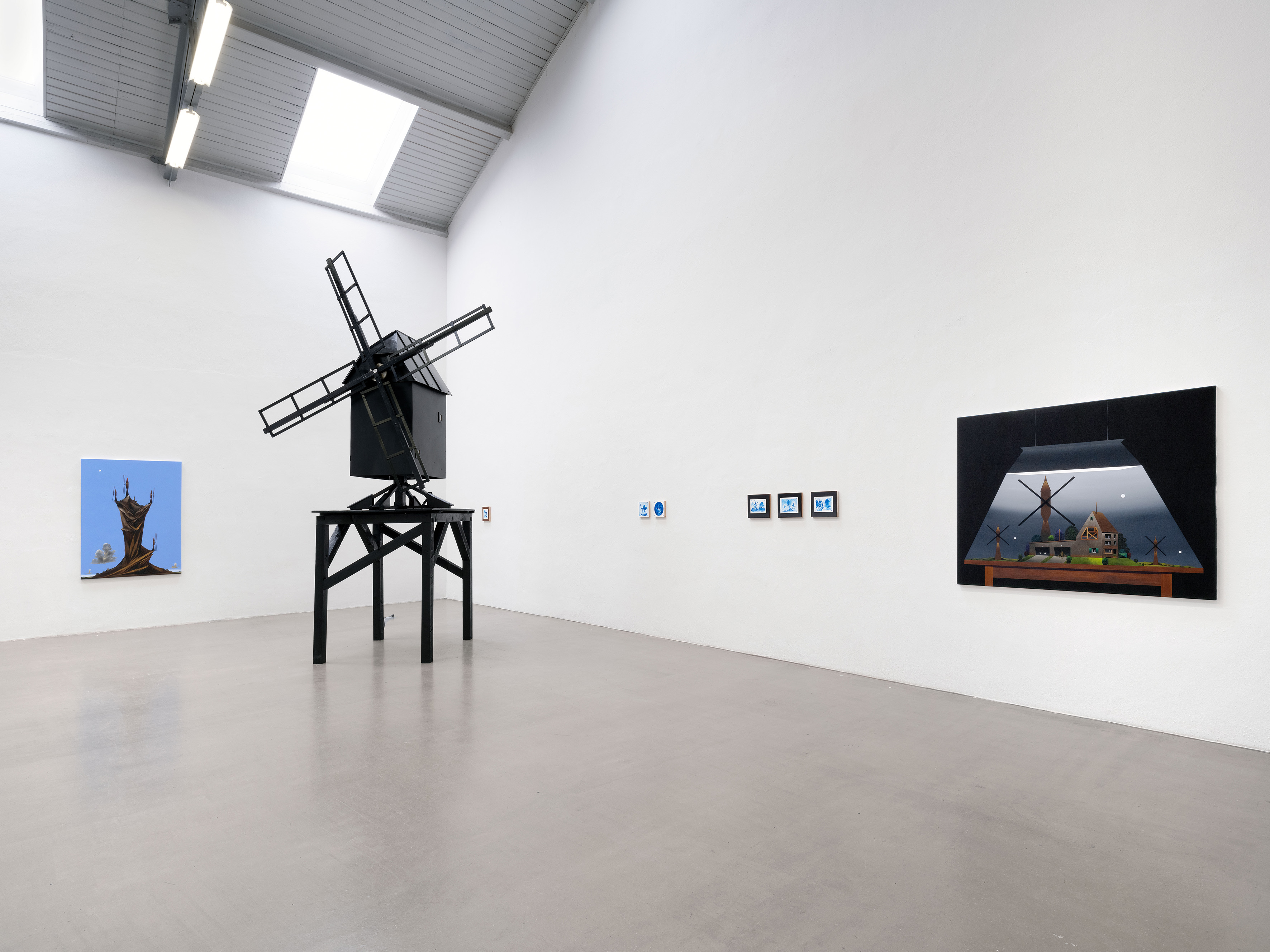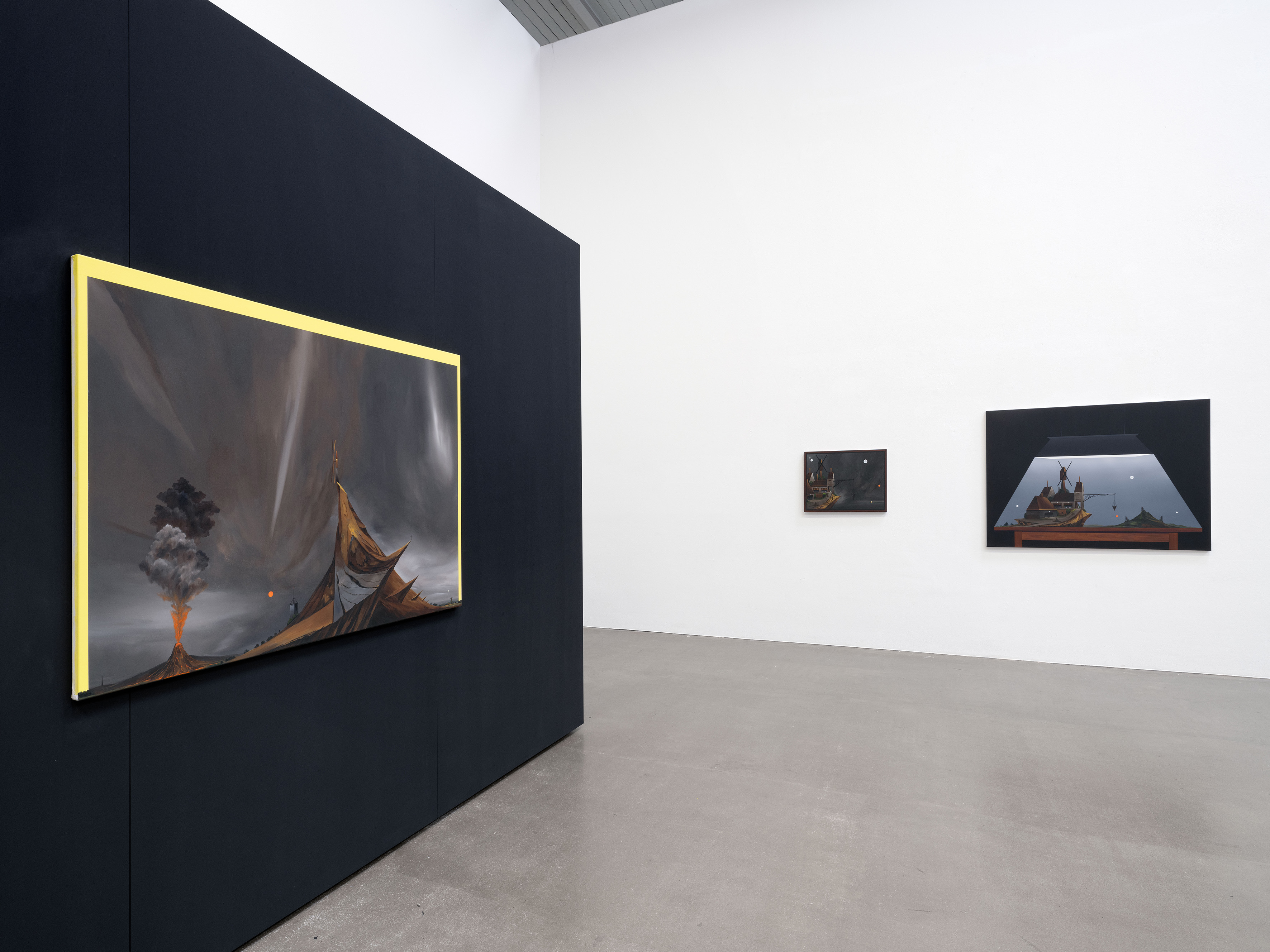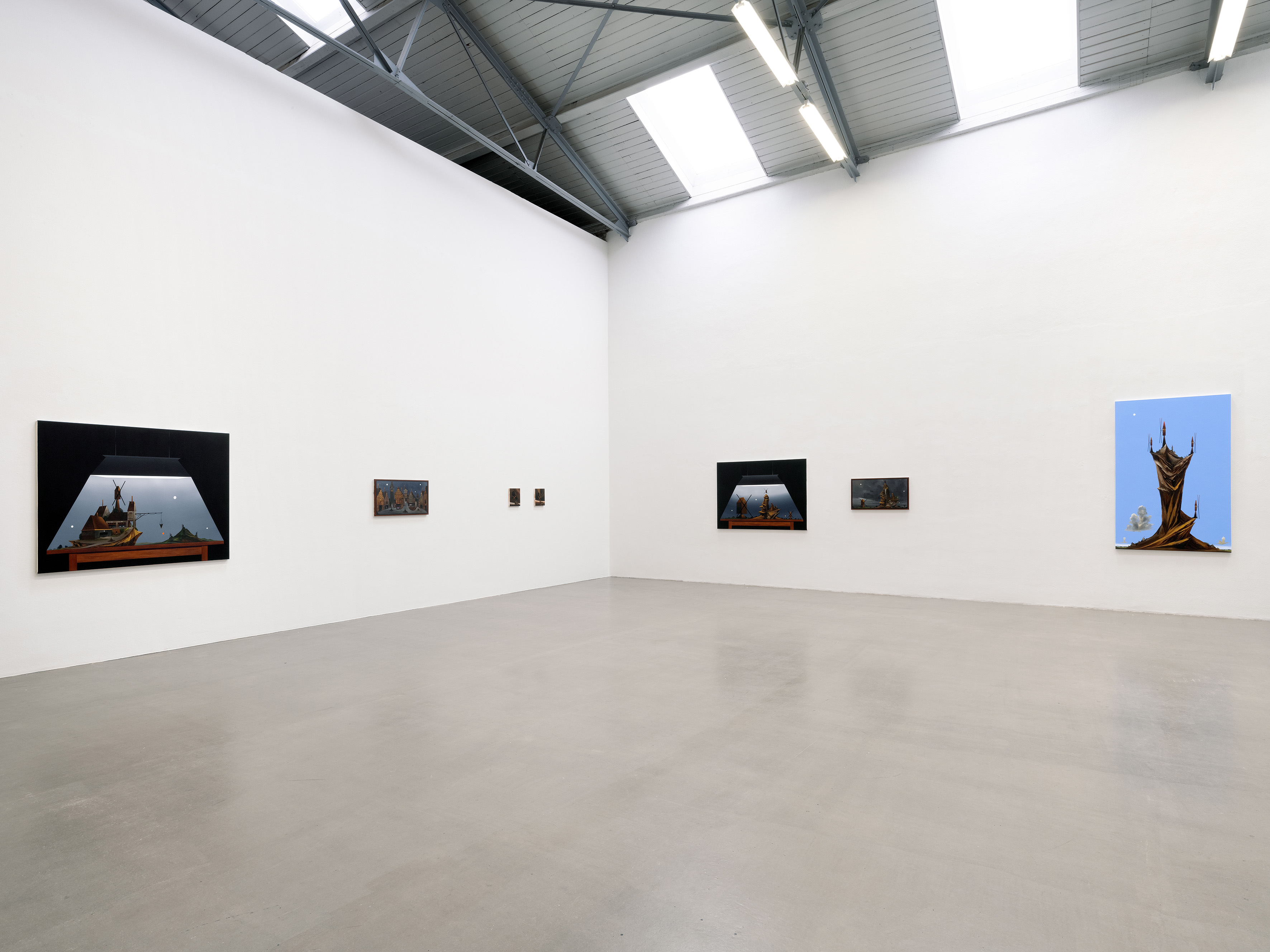Titus Schade
Die Schwarze Mühle
April 22 - June 3, 2023
Galerie EIGEN + ART Leipzig
Spring tour of the SpinnereiGalleries
Saturday, April 29, 2023, 11am – 7pm
Sunday, April 30, 2023, 11am – 4pm
 A central motif in the work of the Leipzig painter Titus Schade is the windmill. The unostentatious, wooden buildings with their expansive arms are placed on gloomy townscapes and dystopian landscapes in varied positions and sizes: sometimes they are fragile structures at the foot of an erupting volcano, threatened by lava; sometimes they are enthroned in intimidating dimensions over a housing complex.
A central motif in the work of the Leipzig painter Titus Schade is the windmill. The unostentatious, wooden buildings with their expansive arms are placed on gloomy townscapes and dystopian landscapes in varied positions and sizes: sometimes they are fragile structures at the foot of an erupting volcano, threatened by lava; sometimes they are enthroned in intimidating dimensions over a housing complex.
The almost neurotic re-use of the same motifs, like windmills, half-timbered houses, or volcanos, and the meticulously controlled placement of lines make the pictures seem staged. Self-reflectively, Schade makes the artificiality of his works into a theme of its own. He places his motifs on a shelf like toys, sets them as the backdrop of a stage or arranges them in miniature on a table. Rather than creating the illusion of a naturalistic depiction, Schade reveals himself as the creator of his ever-newly composed, uncanny pictorial world.

The transformation of elemental forces to gain usable energy made the windmill a sign of technological progress, until it was replaced in this role by the steam engine in the 19th century. However, the X-shaped position of the windmill arms in Schade’s works presents a pause in the milling process. Time seems to have stopped in his pictures. Despite an imminent storm or erupting volcano, the deserted scenes emanate a spooky stillness.
Thus, his windmills are hardly reminiscent of their picturesque predecessors in Dutch landscape painting, in which the ubiquitous buildings became a common motif as early as the 15th century.*1 Rather, his mills evoke associations with works in which they appear as meaning-charged conveyers of mood. For example, in an ominous-looking work by Rembrandt from 1645/48, a Mill stands in front of a threatening, stormy sky (National Gallery of Art, Washington, D.C.). And in Pieter Bruegel the Elder’s 1564 The Procession to Calvary, a mill on a craggy mountain behind the confused pictorial commotion in the foreground symbolically rises into the heavens (Kunsthistorisches Museum Wien).*2
Titus Schade’s mysterious mills also take up a topos frequently found in literature which is based on the sites of the buildings. Most mills were located outside of villages, where they had better wind conditions on hills or open fields. Their remote and solitary position often led to rumors and superstitious gossip. In literature, mills were turned into sites of black magic and the miller into a sorcerer in a pact with the devil. The best-known example is the Lusatian region’s Krabat saga, which traces back to the 19th century and was later taken up in novels by Jurij Brězan and Ottfried Preußler.*3 In both narratives, the Sorbian orphan boy Krabat becomes caught in the clutches of an evil sorcerer, who keeps him captive and makes him work as an apprentice in a mill of black magic.

The figure of the mighty sorcerer exploiting his apprentices can be translated as a critical commentary on the imbalanced relationship between the miller as entrepreneur and the peasants dependent on him.*4 The mill in Bruegel’s The Procession to Calvary was interpreted in this context: instead of God, who looks down in anger from Heaven at the crucifixion of His Son, it is a mill, whose arms recall Christ’s Cross, and the associated miller who are enthroned above the scene. With his position, the miller determines the fates of those situated below him. In Bruegel’s painting, he also has the power to freeze the depicted swarming crowd and to make time stand still.*5
Schade likewise makes time stand still in his works. In his pictorial self-reflection as creative artist, he shows himself as having the power to stop humanity’s hustle and bustle. In his works, the mill is neither aestheticized as a sign of progress, nor nostalgically stylized as an emblem of the “good old days”. Along with hearths and cars – achievements for human civilization – it is condemned to a lonely persistence. Thus, instead of leaving rule over the course of time to a machinery, the painter takes this power literally into his own hand.
Thus, his works can be read as commentaries on a fast-paced, progress-driven society. At the same time, the position of the windmill is renegotiated. It must stand up to deadly volcanos or violent storms – a negotiation of power between cultural progress and dangerous natural forces, in which Schade himself retains the controlling upper hand.
– Helene von Saldern
translated by Mitch Cohen

1 See Michael Philipp’s essay on the iconography of windmills in the Netherlands, which will be published in: Clouds and Light: Impressionism in Holland, exh. cat. Museum Barberini, Potsdam 2023.
2 Scholars have interpreted the mill in Bruegel’s work in various ways. In its own time, it could be understood as the mill of hosts, standing for the transubstantiation of bread into the body of Christ – see Manfred Sellink: Bruegel: The Complete Paintings, Drawings and Prints, Ghent 2007, cat. 127, pp. 191–92.
3 Jurij Brězan: Die schwarze Mühle, Berlin 1968; Ottfried Preußler: Krabat, Würzburg 1971; see Günter Bayerl: Sagenhafte Müllerburschen: Pumphut und Krabat, in: Krabat: Analysen und Interpretationen, ed. by Kristin Luban, Cottbus 2008, pp. 57–69, here p. 58, 69; Klaus Kornwachs: Krabat als Mythos?, in: ibid., pp. 97–115, here p. 109.
4 See René Schuster: Im Bann der Schwarzen Mühle, in: ibid. pp. 211–13, here p. 212.
5 Director Lech Majewski arrives at this interpretation in his film: The Mill and the Cross, Poland, Sweden 2011, based on Michael Francis Gibson’s detailed analysis of the work: Portement de Croix: Histoire d’un tableau de Pieter Bruegel l’Aîné, Paris 1996.